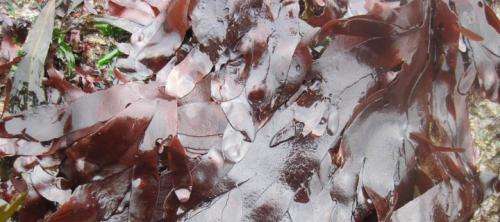Edible seaweed provides an alternative protein source

Teagasc researchers are looking to seaweed for proteins with health benefits for use as functional foods. Historically, edible seaweeds were consumed by coastal communities across the world and today seaweed is a habitual diet in many countries, particularly in Asia. Indeed, whole seaweeds have been successfully added to foods in recent times, ranging from sausages and cheese to pizza bases and frozen-meat products.
Source of protein
Researchers have previously shown that protein-rich red seaweeds such as Palmaria palmata (common name Dulse) and Porphyra (common name Sleabhac or Laver) species may potentially be used in the development of low-cost, highly nutritive diets that may compete with current protein crop sources such as soya bean. For example, the protein content of Dulse varies from between 9-25% depending on the season of collection and harvesting. The highest percentage protein per gram of dried whole seaweed is normally found in P. palmata collected during the winter season (October – January). Valuable amino acids such as leucine, valine and methionine are well represented in Dulse. In Porphyra species, the amino acid profile is similar to those reported for leguminous plants such as peas or beans.
Health benefits of seaweed
Today, cardiovascular disease (CVD) accounts for more than 4.3 million deaths each year and high blood pressure is a main cause of CVD. In addition to its use as a protein source, the researchers have found that some of these seaweed proteins may have health benefits beyond those of basic human nutrition – for use in functional foods.
Bioactive peptides are food-derived peptides that exert a physiological, 'hormone-like', beneficial health effect. Proteins and peptides from food sources such as dairy, eggs, meat and fish are well documented as agents capable of reducing high blood pressure and are thought to be able to prevent CVD.
ACE-I inhibitors are commonly used as therapy in reducing high blood pressure. Food-derived peptides may act as inhibitors of important enzymes such as Angiotensin I converting enzyme (ACE-I) and renin.
The researchers found a renin-inhibitory peptide in the seaweed Palmaria palmata. This is significant as renin-inhibitory peptides have not been identified from seaweed species before.
These renin inhibitory peptides are currently being assessed in bread products for human consumption. Research work at Teagasc will also assess the effects of the P. palmata protein hydrolysates on the technical and sensory attributes of bakery products, in particular bread. "Currently, analysis of a P. palmata bread product is underway and the effects of the hydrolysate on the moisture content, ash, crude fat, fibre and protein content have been assessed. The effects of the seaweed protein on the colour and texture profile of the bread are also being carried out," says researcher Dr Maria Hayes at Teagasc Food Research Centre, Ashtown.
"It is also possible that protein isolated from P. palmata as part of this study could be used for technical purposes in food manufacture, for example in the manufacture of reduced fat products," says Dr Hayes.














